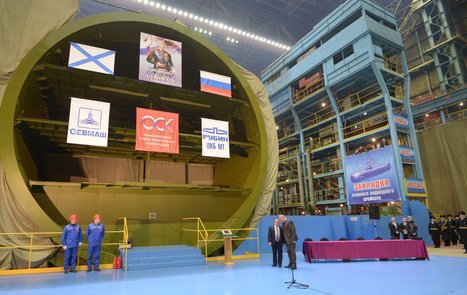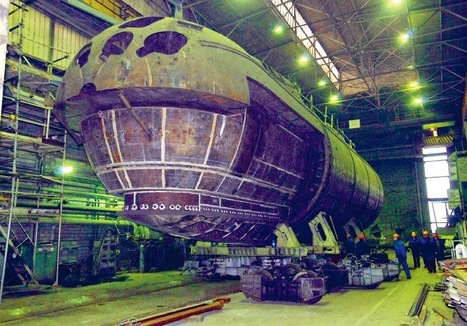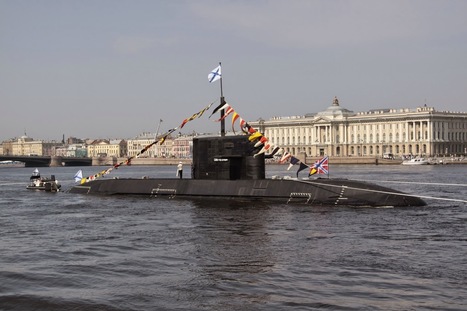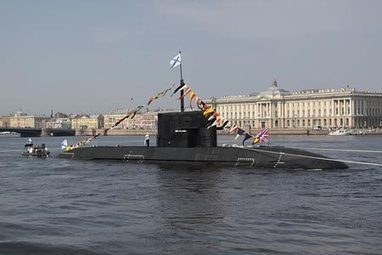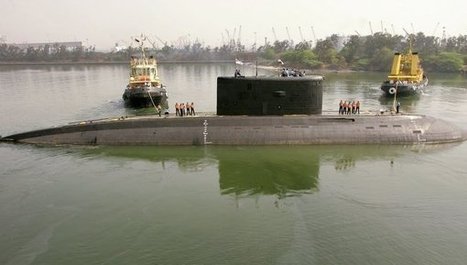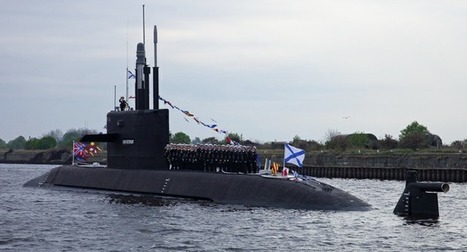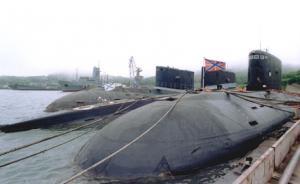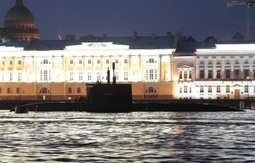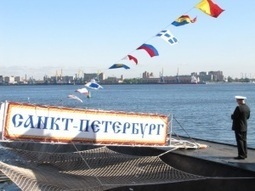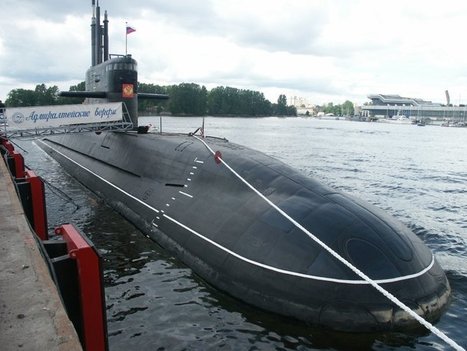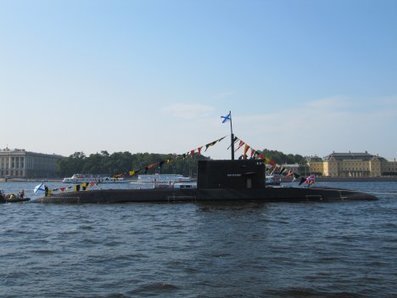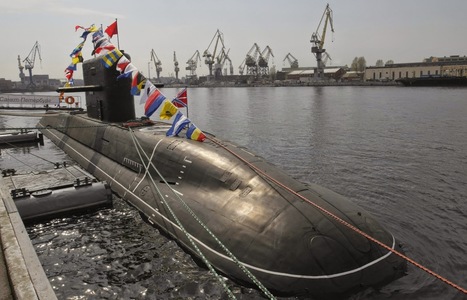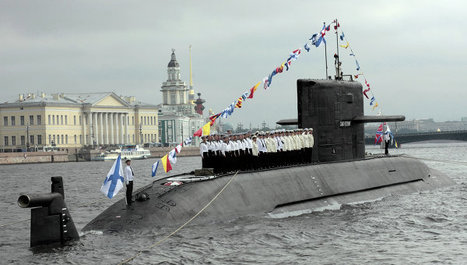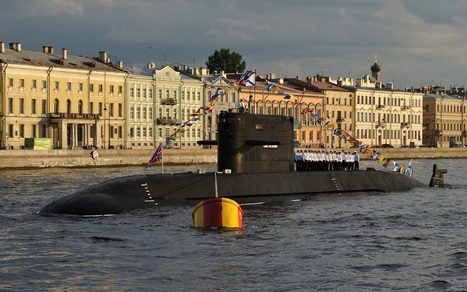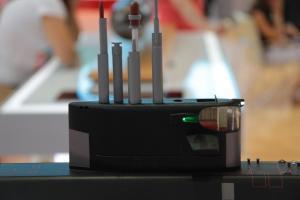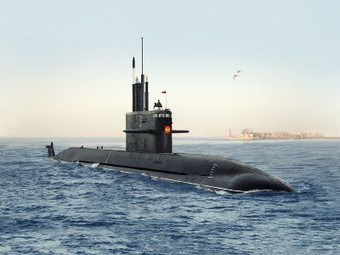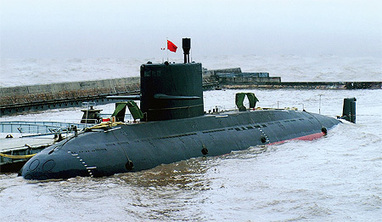 Your new post is loading...

|
Scooped by
Patrick H.
|
The multirole Yasen-class nuclear sub Arkhangelsk and the diesel-electric Lada-class Velikiye Luki have been laid down as part of Submariners' Day celebrations. Two new submarines will be laid down to celebrate Russian Submariners' Day on March 19, the Arkhangelsk, a 120-meter Yasen-class nuclear submarine and Velikiye Luki, a 72-meter Lada-class diesel-electric submarine as part of the rearmament program which will complete in 2020. A Strategic Goal
Currently there is only one Yasen-class multirole submarine in the Russian Navy, the Severodvinsk, seven of which are expected to be made. Notably, the submarines are made using solely Russian defense industries, as components made in the former USSR have been phased out. Multirole nuclear submarines have been growing in importance internationally, and in the US Navy, they have been slowly pushing out strategic subs, as since 2004, 11 Virginia-class submarines have been built and seven more are in the works. Meanwhile, the last strategic nuclear sub made in the US, the Ohio-class USS Louisiana, was laid down in 1992. Strategic nuclear submarines and multirole submarines form the foundation of the Russian Navy's Submarine Forces. By 2020, the state rearmament program projects that the navy will receive eight Borei-class strategic nuclear submarines, three of which have already entered service, and two more of which will be laid down by 2016. Quieter Than Water Meanwhile, Lada-class diesel submarines are meant to replace the Varshavianka-class, two of which are currently in service in the Black Sea Fleet, a third undergoing trials, and three more are under construction but expected to be in service by in 2016, after which the contract won't be renewed. The Lada was meant to replace the Varshavianka in the late 1990s, but issues with the engine and acoustic isolation caused the first ship, the Saint Petersburg, to only be finished in 2010. The new Velikiye Luki submarine will be built according to a new, modernized project, and will have "improved stealth parameters and extended autonomous operation," according to Navy Commander Viktor Chirkov. This most likely means a new engine which does not depend on the submarine's oxygen supply, which gives submarines improved stealth and allows them to stay underwater longer. The Varshavianka, called the "Improved Kilo" in NATO terminology, has been called the "Black Hole" by the organization because of their quiet operation. The project dates back to the 1970s, and is considered one of the best diesel submarine projects, as despite its stealth, it has six 533-mm torpedo bays which automatically reload every 15 seconds.

|
Scooped by
Patrick H.
|
SUBMARINE "KRONSHTADT": FIRST MODULE ON BUILDING WAY!
December 15, 2014
In the coming days, the bow module section of the second Project 677/Lada-class submarine "Kronshtadt" will be transported from Workshop 9 to Workshop 12. Today, construction of the serially-produced unit, which was restarted in July 2013, is in full swing.
In 2009, the Ministry of Defense ordered a halt to the construction of "Kronshtadt", which was laid down in 2005. Four years later, this unique project was given a "second life" - a state contract to continue construction was signed by RF deputy defense minister Yuriy Borisov and Admiralty Shipyards general director Aleksandr Buzakov.
New Life for Lada Project
Today, the bow and stern module sections of the second Project 677 submarine are in Workshop 9, and internal structures requiring rework have been dismantled. The bow module is being prepared for transport to a construction way in Workshop 12. It's symbolic that Bay 6, the same bay used for the construction of "Sank-Peterburg", has been prepared to receive the new bow module.
Work continues on the stern module - a joint in the fourth compartment has already been cut, and upgrades to the end of the stern section is underway.
"In accordance with drawings we received from our designer, Rubin Central Design Bureau of Naval Technology, adjustments were made to the design of the shaft line, which is why the stern section tip is undergoing modifications. To this end, serious efforts are underway," explains project manager and Construction Department 6 senior builder Viktor Mishkin. "The layout of some spaces has changed somewhat - mostly in the fourth and fifth compartments, where the diesel generators and electric propulsion motor are located. Work is also underway to improve designs; this requirement arose while the first hull was being tested."
According to the project manager, the changes being made are primarily focused on improving technical characteristics and habitability, as well as simplifying the ability to service onboard systems.
At the same time as the submarine's construction, a lot of effort is underway to survey structures that were completed earlier. Outfitting buildings and units and machine-building equipment have been activated.
According to Viktor Mishkin, construction of the submarine hasn't reached the most intensive phase yet. Only the scope of work clearly defined by the designers are underway: "As soon as we receive drawings, we immediately start working. First and foremost, the reliability of the submarine depends on clear adherence to the parameters set forth in the design."
Workshop 9 employees - builders under the supervision of Oleg Sosunov, assemblers led by Nikolay Borisenko, teams of welders nuder Roman Shemenkov and Valeriy Kichigin - are now actively involved in the construction. Preparation of the bow module section for transport to Workshop 12 is being handled by Vladimir Kozlov's assembly team and Yevgeniy Agapov's metal worker team. These are the same workers who participated in construction of the first Project Lada submarine.
A majority of the work is also being performed by Workshops 6 and 7 and by machine-building production personnel.
The transfer of the stern module section into Workshop 12 is scheduled for spring 2015. During this time, the submarine's hull will be prepared for insulation work. "Habitability conditions inside the submarine depend on the quality of insulation, and this step also helps prevent accumulation of condensation, which is not desired when operating machinery," explains Viktor Mishkin. "After insulation work, the module section can be moved to the construction way, where installation of equipment will begin."
Upon completion of the first stage of construction in Workshop 9, all factory teams will be brought in to work on the submarine.
We Create... And Build
Despite the fact that "Kronshtadt" is not a lead hull, it is being built using a corrected technical design. "Nearly 20 years have passed since the draft design was completed," says Construction Department 6 senior builder Mark Khazanov. "Since then, based on construction and testing experience, new types of equipment and requirements have materialized, which the designer has reviewed and which will be introduced during construction. We could consider that, at some level, "Kronshtadt" - for us - is a submarine that isn't being built, but rather created. There's a difference!"
New, Modern!
Currently, Project 677 submarines are the most modern non-nuclear submarines. Despite the large scope of work, timelines for building this unique submarine are rather tight: according to the signed documents, the transfer of "Kronshtadt" to the Russian Navy is scheduled for 2017.

|
Scooped by
Patrick H.
|
Construction of the second hull of the Petersburg diesel submarine class, named "Kronshtadt", was restarted in July 2013 when a new contract (Z/1/2/0280/GK-13-DGOZ) was signed with Admiralty Shipyards. Construction was stopped in 2009 after the Russian Ministry of Defense decided it would no longer fund the plagued program following the poor performance and prolonged testing of the first hull, "Sankt-Peterburg". But "Kronshtadt" is now showing signs of life.
"Sankt-Peterburg" was laid down in December 1997 and launched in October 2004. During factory testing, multiple issues with sonar, power plant, and propulsion systems significantly impacted the submarine's ability to achieve the technical and tactical performance requirements set by the Russian Navy. The submarine was finally commissioned in April 2010 - but only for "trial operations." After several years of limited operations, the submarine was transferred from the Baltic Sea to the Barents Sea in October 2013 for additional at-sea testing. "Sankt-Peterburg", which remains in a "trial operations" status, apparently has conducted few (if any) at-sea operations since the transfer based on a total lack of reporting.
"Kronshtadt" was laid down at Admiralty Shipyards in July 2005, and little information about the submarine was known about it after construction was halted in 2009. Since the new contract was signed in July 2013, however, there have been signs that real construction is underway, as proven by a dozen contracts for equipment deliveries announced between December 2013 and now.
(Description / cost / delivery date) - 72V29KM rapid remote-control equipment / ??? / 1Q2015
- hydraulic mooring anchor capstan / ??? /2Q2015
- reserve propulsion system / ??? /1Q2016
- LGS-42 winch / ??? / 2Q2015
- oil-water separators / ??? / 1Q2015
- ARM-5 automated steering apparatus / ??? / 4Q2015
- automated air compressor systems / ??? / 1Q2015
- Baget 41-10 computer / ??? / 3Q2015
- modernization of Zhikler mast-raising devices / RUB 1,780,800 / ???
- Gnom-2 acoustic digital recorder / ??? / 4Q2015
- diesel generators / ??? / 3Q2015
- MG-65 emergency underwater communications system / ??? / 2Q2015
- diesel generator pedestals / RUB 5,332,671 / Jan 2015
When the new contract went into effect in July 2013, Admiralty Shipyards reported that "Kronshtadt" was scheduled for handover to the Russian Navy in 2017. While the completion dates for the above contracts seem to suggest a 2017 delivery date is possible, it remains to be seen if sub-contractors for components can stay on schedule.

|
Scooped by
Patrick H.
|
The B-585 Sankt Peterburg, Russia's first and only completed Lada-class submarine. (Internet photo) Instead of providing the older Lada-class submarines to the People's Liberation Army Navy as requested by Beijing, Russia's president, Vladimir Putin, will likely authorize China to receive the more advanced Kalina-class submarine, reports the Voice of Russia, citing Vassily Kashin, a senior research fellow from the Moscow-based Center for Analysis of Strategies and Technologies. Viktor Chirkov, the commander-in-chief of the Russian Navy, officially announced that the Kalina-class conventional submarine equipped with an advanced air-independent propulsion system will be developed and produced in the future on Mar. 20. "Russia is currently designing a fifth-generation conventional submarine, dubbed Project Kalina, which will be fitted with an air-independent propulsion (AIP) system," said Chirkov. Authorities also declared that the construction of the older Lada-class submarine will be cancelled. The Lada-class, or Project 677, is a fourth-generation diesel-electric submarine based on the older Kilo-class submarine. China was negotiating with Russia to purchase four Lada-class submarines from the Rubin Design Bureau based in St Petersburg. China hoped those submarines could be refitted with Chinese engines and an electronic fire-control system, according to the Canada-based Kanwa Defense Review. As Russia remains isolated over its intervention in the Ukraine crisis, Moscow values China's position as one of its strategic partners, Kashin said. He added that the PLA Navy will benefit from the cancellation of the Lada-class as it will open a new door for China to gain more advanced technology from Russia to build its own submarine in the future. Meanwhile, China may be able to design its own fifth-generation conventional submarine with the help of Russia under this new concept, Kashin said.

|
Scooped by
Patrick H.
|
Trial operation of the lead submarine of the 4th generation "St. Petersburg" (Project 677 class "Lada") will be completed in 2014, and after that it will be on alert, said on November 28, ITAR-TASS General Director of "Admiralty Shipyards" Alexander Buzakov.
Buzakov also reported that an export contract is planned in 2014 with the with the Navy one of the countries involved in the construction of submarines of Project 636. Now "Admiralty Shipyards" are building for the Vietnamese Navy 6 submarines of this project.
Submarine "Saint Petersburg", designed to CDB Marine Engineering "Rubin" (St. Petersburg), was launched on September 8, 2004, in October 2006 completed mooring trials, and in January 2007 began the final stage of its sea trials. In April 2010, the boat was accepted into the Russian Navy in trial operation. The first production boat of this project - "Kronstadt" was laid on the stocks "Admiralty Shipyards" July 28, 2005, but later construction was suspended and resumed only in 2013.
The second serial submarine - "Sevastopol" laid in the first quarter of 2006. It is expected that these ships will be equipped with a series airindependent installation, which will provide additional stealth military campaigns.
Class submarine, "Lada" is designed for independent operations on the sea lanes against submarines and surface ships of the enemy in a limited area of the ASW in coastal areas, and narrows in heavy areas of mine fields and other tasks.
Diesel-electric submarines of Project 677 - the fourth generation diesel submarines of the postwar period, which is an improved version of submarines "Varshavyanka" Project 636. Submarines of this type are designed for independent operations against submarines and surface ships in the local area, to attack ground targets with the use of sea based cruise missiles, anti-submarine warfare in coastal areas, and the narrowness of the strait zones, combating maritime communications in restricted areas, etc. etc.
Project 677 submarines were much quieter than their predecessors. This feature they got through monohull architecture and application of high-tech body antigidroakusticheskogo coverage. The submarine is equipped with a new type of sonar system "Irtysh" advanced antenna system and flexible extended towed antenna. Has increased autonomy (up to 45 days), increased cruising range submerged up to 650 miles at a speed of 3 knots stroke.

|
Scooped by
Patrick H.
|
La Russie réparera et modernisera quatre sous-marins diesel-électriques indiens de classe Kilo pour 150-200 millions de dollars chacun, a annoncé jeudi à Cochin Evgueni Choustikov, directeur général adjoint des chantiers navals russes Zvezdotchka. "Le coût des travaux sera le même que pour la modernisation de l'INS Sindhurakshak", soit de 150 à 200 millions de dollars pour chaque sous-marin, a indiqué M.Choustikov au premier salon naval international NAMEXPO-2013. Le responsable avait annoncé mercredi que l'Inde comptait faire réparer et moderniser quatre sous-marins diesel-électriques pareils à l'INS Sindhurakshak que les chantiers navals Zvezdotchka ont remis à l'Inde le 26 janvier 2013. Deux des quatre sous-marins indiens seront réparés et modernisés en Russie et les deux autres en Inde, d'après lui. "Pour le moment, nos partenaires indiens souhaitent que nous effectuions les mêmes travaux de rénovation et modernisation que ceux réalisés à bord du Sindhurakshak", a précisé M.Choustikov. Il s'agit notamment de remplacer les accumulateurs et les systèmes hydroacoustiques des submersibles. New Delhi n'a pas l'intention de remplacer les armements. "Les Indiens étudient la possibilité de doter les sous-marins de missiles BrahMos, mais ils n'en parlent que dans les discussions informelles. Nous le ferons si c'est nécessaire, nous en avons les possibilités techniques", a conclu M.Choustikov. L'INS Sindhurakshak est un sous-marin du projet 877 EKM (version export du projet Paltus/Kilo selon la classification de l'OTAN) construit aux chantiers navals de Saint-Pétersbourg en 1995 sur demande de la Marine indienne. Fin août dernier, le Sindhurakshak a partiellement sombré au port de Bombay (Mumbai) suite à un incendie et plusieurs explosions à bord. La Marine indienne a expliqué l'incident par une erreur humaine lors du chargement de missiles.

|
Scooped by
Patrick H.
|
The Indian Navy is just one step away from issuing a global tender worth almost eight billion dollars for six conventional stealth submarines. Russia is among the four countries which are in a vantage position in bagging the upcoming contracts, the other countries being France, Sweden and Germany, though not necessarily in that order. Indian Navy’s Vice Chief, Vice Admiral R K Dhowan, said at a press conference in New Delhi on Monday, September 16 that the navy’s proposal for having six hi-tech submarines will be soon placed before India’s apex decision-making body on defence and strategic matters the Cabinet Committee on Security (CCS). Vice Admiral Dhowan informed that the Defence Acquisition Council (DAC), headed by Defence Minister A K Antony, had given its approval for the proposal to be taken up before the CCS and the global tender will be issued after the CCS nod comes. The navy vice chief said the tender would be worth Rs 50,000 crore, which is about $7.92 billion at today’s exchange rates. Sources said the CCS may meet “very soon”, perhaps before Prime Minister Manmohan Singh, who heads the CCS, leaves for his week-long trip to the United States on September 25. Details of the Indian Navy’s Proposal The Indian Navy plans a unique 2+2+2 format for adding the proposed six submarines to its fleet. Sources said the prevailing thought in the Indian Navy is to go for outright purchase of two submarines from abroad and order two submarines each for Indian public sector and private sector companies. Russia is the world’s leading submarines exporter having exported 168 submarines to well over a dozen countries in past fifty years and thus a top contender for the upcoming Indian order. Moreover, sources said Russia was well qualified to have stakes in the entire 2+2+2 format. Russian companies can forge tie-ups with Indian PSUs and private companies for construction of four submarines in India and New Delhi is likely to encourage that. Vice Admiral Dhowan put this point in perspective with a pithy remark: “Navy is poised for growth... over the next decade, we plan to induct at least four to five major combatants (warships and frigates) every year. This provides an ideal opportunity for Indian shipyards and industry to enter into collaborative arrangements or joint ventures.”' Dhowan elaborated that 46 warships and submarines are currently under construction in Indian shipyards. India has of late started laying stress on indigenization but considering that neither the public sector nor the private sector companies are technically competent to build hi-tech submarines on their own, New Delhi has been giving a free hand to these companies to enter into collaboration with foreign companies. Russian companies must be well aware of this and should be on the job. Two more reasons to cheer for Russia Then there are two more reasons to cheer for the Russian companies to scour the Indian naval market which Vice Admiral Dhowan briefly referred to but stopped short of giving details. One, he said in the wake of virtual destruction of INS Sindhurakshak submarine in devastating explosions on August 14, the Indian Navy was actively considering a refit and repair of its existing fleet of conventional submarines. The Indian Navy currently has 13 operational submarines, nine of which are of Russian origin. Since these Kilo-class submarines were first inducted into the Indian Navy well over a quarter century ago and most of them have already served their effective life of 20 years, their refit and repair is long overdue....

|
Scooped by
Patrick H.
|
Five new submarines (NNS) 06363 and 677 projects will be put into the Russian Navy in the years 2015-17. However, three boats will be on the Black Sea Fleet, and two - the Northern Fleet. This is korr.ARMS-TASS reported on September 18, defense-industrial complex.
Submarines of Project 06363 design of the Central Design Bureau for Marine Engineering (CDB ME) "Ruby" - "Novorossiysk", "Rostov-on-Don" and "Stary Oskol" built on "Admiralty Shipyards" in St. Petersburg. On the "Novorossiysk" is now almost formed hull. However, because of the Vietnamese-order construction of six submarines export 06,361 construction project is delayed, and lowering the boat will take place no earlier than spring 2014. On the "Rostov-on-Don" and "Stary Oskol" is now being assembled hull blocks. All three of these submarines after adopting in 2015 will be part of the Black Sea Fleet.
On the "Admiralty Shipyards" non-nuclear submarines are under construction, and two Project 677 CDB ME "Rubin" - "Kronstadt" and "Sevastopol". The contract for the construction of the "Kronstadt" was thawed July 9, 2013 after the necessary modifications of the project and conduct research. The planned deadline boat that will actually be a modernized version of the head boats Project 677 "St. Petersburg" (code "Lada") - 2017.
NNS "Sevastopol" is selected as the head of the new airindependent installation (VNEU), construction of which is currently being piloted. Since July 2013 on the draft boats began work associated with modernization and change the project to install VNEU. The planned deadline boat - 2017. But it may be postponed due to delays associated with the development of VNEU.
Both submarines of Project 677 after the completion of the entered service of the Northern Fleet.

|
Scooped by
Patrick H.
|
The first full-scale /staging/ sample of an air-independent power plant for non-nuclear submarines will be created in 2016, the Russian Navy’s Commander-in-Chief Admiral Viktor Chirkov said on Saturday. "In 2016, a full-scale model of anaerobic power plant, designed at "Rubin", will be ready, and the following year, 2017, this system may be installed at the first Lada submarine project 677,” he said. “It would be a different, modernised project of submarines of the class with several different, more technological parameters.” "These anaerobic systems, as they are completed at "Rubin," will be used for future promising non-nuclear submarines of Lada class, which, surely, will serve also at the Northern Fleet," the admiral said. He continued saying the use at non-nuclear submarines of anaerobic power plants would add to their level of secrecy, would reduce further the noise, increase endurance, which "undoubtedly will have a positive impact on effectiveness of their combat missions."

|
Scooped by
Patrick H.
|
24.04.2013 Diesel-electric submarine (SSK) of a series of 677 "Lada" "Saint Petersburg" is now preparing to move to the Northern Fleet, where he will test the boat. This was at a conference on "Russia's shipbuilding industry: the rise or decline of the industry?" Held on April 24 in St. Petersburg, the first deputy general director of OAO "CKB" Rubin "Valentin Alexandrovich Frolov.
The crew of the Northern Fleet has already made diesel-electric submarine "Saint Petersburg", replacing the sailors of the Baltic Fleet.
According to Valentin Frolov, the date of transfer of the boat to the Northern Fleet Command depends on the decision of the Navy Rosii, as is currently considering a proposal to participate in the boat 6th International Maritime Defense Show (IMDS 2013). In addition, the diesel-electric submarine "Saint Petersburg" to take part in providing test export submarines for the Vietnamese Navy and built by Severnaya Verf ships.
Recall the construction of two submarines "Sevastopol" and "Kronstadt" Project 677 "Lada" to "Admiralty Shipyards" was frozen previous commander in chief of the Russian Navy Admiral Vladimir Vysotsky, because the lead ship of a series of "St. Petersburg" has not shown stated in the project characteristics.
Boats are designed to destroy submarines, surface ships and enemy ships, protection of naval bases, sea, and the sea lines of communication, reconnaissance. The ship's tonnage of 1,765 tons, a maximum depth - 350 m, speed - 21 knots, the crew - 36 people, autonomy - 45 days, armed with torpedoes and rocket-torpedoes, air defense systems "Igla-1M".

|
Scooped by
Patrick H.
|
Contract for continued construction of the second non-nuclear submarine of project 677 (code "Lada") will be signed between the Ministry of Defence and the JSC "Admiralty Shipyards" this summer. In an interview with the press factory deputy director general of the shipyards to produce Andrey Bystrov.
"While we are building a submarine project" Lada "[apparently, the NNS B-586" Kronstadt ", serial number 01571, laid down in the shed of the company July 28, 2005. - Ed.] - A contract which must be signed no later than the summer "- said Andrey Bystrov.
"Already allocated funding for this order and signed by the General Director of the preparations for its construction. Therefore organizational work has already started," - said zamgeneralnogo director.
"Harmony" - a new generation of spacecraft. In the future, the military said on its base to be built boats airindependent power plant. And this - the technical development yards and professional development of our employees "- said Bystrov.
Recall that the leading non-nuclear submarines of the "Lada" - B-585 "St. Petersburg" entered the Navy in May 2010, after nearly twelve and a half years of construction and testing. Despite the effort, fully operational NNS "St. Petersburg" is still not reached .
Construction of the second boat - "Kronstadt" and the next - B-587 "Sevastopol" (founded at the Admiralty Shipyards in November 2006) has been put on hold by the decision of the previous Navy Commander Admiral Vladimir Vysotsky, because of poor technical characteristics identified in the operation of the head in the NNS Navy.
The decision on the continuation of the construction of this type of NNS Adjusted technical project adopted a new Navy Commander Admiral Viktor Chirkov summer 2012.

|
Scooped by
Patrick H.
|
BEIJING: China has agreed to buy two dozen fighter jets and four submarines from Russia, state media reported on Monday, the country's first large-scale weapons technology purchases from Moscow in a decade.
The agreement to buy the 24 Su-35 fighters and four Lada-class submarines was signed just before President Xi Jinping's weekend visit to Russia, said the People's Daily, the Communist Party organ, citing state television.
The report, which did not give a value for the purchases, said it was the first time in 10 years China had bought "large military technological equipment" from Russia. The deal comes as Beijing expands its military reach - it commissioned its first aircraft carrier last year - and is embroiled in a bitter territorial row with Japan over disputed islands in the East China Sea. Two of the submarines will be built in Russia, with the other two to be built in China.
"The Su-35 fighters can effectively reduce pressure on China's air defence before Chinese-made stealth fighters come online," the report said.
China and Russia are expected to co-operate further in developing military technology, the report said, including that for S-400 long-range anti-aircraft missiles, 117S large thrust engines, IL-476 large transport aircraft and IL-78 aerial tankers.
China's defence ministry had no immediate comment on the report.
Xi visited Moscow from Friday to Sunday for talks with his Russian counterpart Vladimir Putin, his first trip abroad since becoming head of state earlier this month.
The countries signed around 30 energy and other agreements during the visit.
Xi also met Defence Minister Sergei Shoigu and became the first foreign leader to visit the Russian armed forces' control centre.
Moscow and Beijing, which were once bitter foes during the Cold War, have strengthened cooperation in recent years to counterbalance what they see as US global dominance.
Earlier this month China announced a further double-digit rise in its defence budget, raising it by 10.7 per cent to 720.2 billion yuan ($116.3 billion) in 2013.
Agence France-Presse

|
Scooped by
Patrick H.
|
Des clients étrangers ont montré un fort intérêt pour le sous-marin classique russe Amur-1650, a indiqué la compagnie publique Rosoboronexport. « Sur les 9 pays qui prévoient de moderniser ou développer leurs flottes sous-marines..., 3 ont déjà choisi le projet Amur-1650, » explique le directeur de Rosoboronexport, Anatoly Isaikin. Il n’a toutefois précisé le nom des pays concernés. « Le développement actuellement en cours des systèmes de propulsion anaérobies pour le sous-marin, devrait encore alimenter l’intérêt des clients, » a-t-il ajouté. L’Amur 1650 est l’un des projets présentés à l’appel d’offres lancé par la marine indienne pour 6 sous-marins. L’Amur 1650 est opposé au Scorpène (France), au U-214 (Allemagne) et au S-80 (Espagne), parmi d’autres. L’Amur dispose de torpilles et de missiles anti-navires, il peut aussi attaquer des cibles à terre avec des missiles de croisière, dont le missile russo-indien Brahmos. L’Amur 1650 peut rester en plongée pendant plus de 25 jours grâce à son système de propulsion anaérobie, soit de 5 à 10 jours de plus que les projets étrangers. Les sous-marins à propulsion anaérobie, qui utilisent généralement des piles à combustible hydrogène-oxygène, sont plus silencieux que les sous-marins classiques et n’ont pas besoin de faire surface ou d’utiliser leur schnorchel pour renouveler leur atmosphère, s’exposant ainsi à être détecté par radar ou d’autres senseurs. L'analyse de la rédaction : La classe Amur-1650 est la version export des Lada construits pour la marine russe. Le premier exemplaire, le Sankt Peterburg, a connu de nombreux problèmes depuis le début de ses essais à la mer en 2005. La construction d’exemplaires supplémentaires a même été gelée en 2011. En 2012, la construction a repris, après d’importantes modifications. A ce jour, malgré des déclarations d’intention dont certaines remontent à 2006, aucun contrat n’a été signé pour la vente de ce type de sous-marins. Référence : RIA Novosti (Russie)
|

|
Scooped by
Patrick H.
|
"The prototype VNEU (airindependent power plant - ed.) Is created, it works. Then go to create VNEU order to use it on the ship" - quoted the general director of the CDB "Ruby" Igor Vilnita RIA Novosti .
The main advantage of airindependent power plant - an increase stealth submarine. The submarine is able to stay underwater without surfacing to recharge the batteries. It is planned that in 2015 the first VNEU will be installed on a submarine of Project 677 "Lada". Parent boat project "Saint Petersburg" is built with the classical power plant and now continues to test. Two other boats of this project is still in the stage of completion of construction, and perhaps they will be tested first anaerobic systems. VNEU will also be mounted on the export versions of Project 677 boats.
VNEU Russian design is fundamentally different from their foreign counterparts by producing hydrogen. Not to carry high-purity hydrogen on board the submarine, the unit has the production of hydrogen in the amount of consumption by means of reforming of diesel fuel.
Commander in Chief of the Russian Navy Admiral Viktor Chirkov told reporters in August that in 2017 Russia starts construction of non-nuclear submarines with a new generation of anaerobic plant.

|
Scooped by
Patrick H.
|
The second Project 677 diesel-electric submarine for the Russian Navy, "Kronshtadt", will be launched in late 2015. Admiralty Shipyards general director Aleksandr Buzakov informed TASS about this at Euronaval-2014. Previously it was reported that work on the submarine "Kronshtadt" should be completed in 2017.
"There is still a year before the launch of 'Kronshtadt'," said Buzakov. "Everything will depend on equipment delivery timelines, and not timelines for conducting factory work. When the equipment shows up, we can talk about more precise timelines for a launch," he added.
The general director reported that one quarter of the hull work on "Kronshtadt" has been completed.
Construction of a third submarine
Admiralty Shipyards has begun construction of a third Project 677 diesel-electric submarine for the Russian Navy, although a contract has not yet been signed. The submarine has been named "Sevastopol", Buzakov explained. "A final contract has not been signed, but the cost and a number of other contract parameters have been agreed to. That is to say, at the present time, several formalities are proceeding to completion. Therefore, part of the work on the submarine is already underway," Buzakov explained, noting that a small percentage of hull work has already been completed as part of the submarine's construction.
The general director noted that the first three Project 677 diesel-electric submarines will not be equipped with air-independent propulsion (AIP). "This will be a series of three submarines that will not be equipped with AIP. The lead unit, "Sankt-Peterburg", is undergoing trial operations. On the other two submarines, everything will be verified in terms of quality and other parameters, which must be raised to the level of the design," Buzakov said.
AIP allows non-nuclear submarines to operate under the water for long periods without having to surface.
Project 677 (Lada) diesel-electric submarines were developed to combat surface ships and were designed for antisubmarine warfare, destruction of enemy naval bases, facilities and sea lines of communication, as well as for intelligence and patrol missions.

|
Scooped by
Patrick H.
|
China reportedly signed two military sale frameworks with Moscow, of which Russia will jointly build four Amur-Class AIP submarines with China and sell them to the country while China will buy 24 Su-35 fighters from Russia, reports Sina's military news portal. It is the first major military procurement China has made with Russia in 10 years, said the report. China needs submarines to counter threats from India's fleet and build a fleet to resist America's influence, said the Voice of Russia, the Russian government's international radio broadcasting service. A manager for a Russian national defense export company said Moscow and Beijing have been negotiating over submarine technologies. China has not revealed how many submarines it wants to buy and has not scheduled to sign a supply contract. It is natural for India and China to show interest in Russia's Amur-Class submarines, said a retired Russian Navy general named Sivkov. The submarine is superior to the export version of China's 877 submarine and China would want the Amur-Class vessel since India has them. The Russian submarine can also effectively fight against American submarines and destroy Los Angeles and Virginia-class nuclear-powered submarines from long distances. Since it produces little noise underwater, American submarines cannot detect the its presence. The characteristic allow the submarine to make fire warning shots or destroy enemy ships effectively during real battles. Although the Amur-Class submarine can attack multiple targets on land, it cannot carry an anti-guided missile system. China does not own any submarine-based anti-missile systems as of now. India's defense ministry made emergency orders over concerns of the country's declining defense capabilities. India has skipped the bidding process and ordered two diesel-electric Amur-Class submarines 677 from Russia to enhance its sea combat capabilities. Currently China owns 60-plus submarines while India has 14 with a leased Russian-made nuclear-powered submarine Nerpa since 2012. The vessel is superior to Chinese submarines since it produces far less noise, said Russian experts. He believes China will not wage a war against India now even though the Chinese fleet has greater combat power than India's. China considers its fleet as a force against America and does not feel threatened by India.

|
Scooped by
Patrick H.
|
MOSCOW, February 21 (RIA Novosti) – Russia’s latest generation attack submarine will be fitted with an advanced ultra-quiet propulsion system within the next three years, the country’s naval commander said Thursday. Admiral Viktor Chirkov said that the first Lada-class attack submarine will be equipped with the air-independent system by 2016, to increase both its range and stealth. The only operational Lada-class submarine, the Sankt Peterburg, entered into service four years ago after more than a decade of construction and sea trials. The navy briefly suspended production of the vessels in 2012, pending design changes. The new propulsion system is being developed at the northern Sevmash shipyard, the country’s largest. Air-independent power plants offer significant advantages over diesel-electric submarines, which must surface regularly to recharge their batteries, and nuclear submarines, which must continually run noisy pumps to cool their reactors. Submarines with such systems can stay submerged for weeks at a time and are already in operation with a number of navies around the world. The United States has so far not employed the technology, however, in favor of the longer endurance and range of nuclear submarines. Chirkov said that in the long-term Russia would move towards building submarines in modular fashion to produce a variety of sizes from standard parts, a common practice in the construction of surface ships. He added that future submarines would also increase their degree of automation.

|
Scooped by
Patrick H.
|
The Ministry of Defence announced that October 10, 2013 in the Murmansk region Polyarny comes submarine "Saint Petersburg" pr.677. It is planned to test deep-sea boats in the Barents Sea. Recall that the Russian Navy submarine accepted into trial operation in 2013 and resumed work on the first two series pr.677 submarines. Boats are being completed by finalized the draft.

|
Scooped by
Patrick H.
|
NAMEXPO 2013 : la Russie répondra à l'appel d'offres indien pour le Projet 75I...avec l'Amur-1650 AIP
The tender for the purchase of the six non-nuclear submarines for the Indian Navy may be announced before the end of 2013, told RIA Novosti on Monday, Deputy General Director of the Central Design Bureau for Marine Engineering "Rubin" Andrei Baranov, the first naval show NAMEXPO-2013.
Earlier it was reported that Russia plans to participate in the Indian tender for the purchase of six 75I submarines for national naval forces with the project "Amur-1650", along with submarines Scorpene (France), Type-214 (Germany) and S-80 (Spain) . According to preliminary data, the cost of the tender will be about 12 billion U.S. dollars.
"The intention to declare the tender is declared by India since 2010, but so far no concrete action has been taken. Now the situation has worsened, and the competition may be announced before the end of the year" - said Baranov.
According to him, the "Amur-1650" - a well-known Indian side of the proposal, negotiations are going on it for three years.
Russia has informed India's readiness to equip diesel-electric submarine "Amur-1650" VNEU after 2016. On the agency "RIA Novosti" on the first naval show NAMEXPO-2013 Deputy Director General of the CDB for Marine Engineering "Rubin" Andrei Baranov.
According to him, "we are informed by our Indian partners that term availability of a prototype VNEU - 2016," - said the agency.
A.Baranov explained that "the prototype VNEU will be a full-sized compartment that assembled all the necessary equipment: cutting in this compartment with the finished installation in an already well-known platform - it's a matter of technique", - the "RIA Novosti".

|
Scooped by
Patrick H.
|
Sources from Russia's Rubin Design Bureau based in St Petersburg said that the Lada-class mini submarines sold to the People's Liberation Army Navy will be equipped with Chinese power and electronic fire-control systems, reports the Kanwa Defense Review operated by Andrei Chang or Pinkov (Andrei Chang), a military analyst in Canada. The purchase was confirmed in a report by the US-based Strategy Page, but it is said that the four Lada class diesel-electric submarines will be modified specifically for China. Based on the PLA Navy's requests, the air independent propulsion system based on oxygen-hydrogen fuel cells — which allows the submarine to extend its underwater endurance to more than 15 days — will be removed. Because the Lada-class submarine will not be used by the PLA Navy for ocean-going combat, the oxygen-hydrogen fuel cell is no longer necessary. The PLA Navy will instead power the submarine's air independent propulsion system with Chinese Stirling engines. The country's Type 041 Yuan-class submarines and Type 032 Qing-class submarines are also equipped with the Stirling engine, the source said. The four Lada-class submarines will also be equipped with advanced electronic systems developed in China and the fire-control system will also be modified to launch Chinese anti-air and anti-ship missiles.

|
Scooped by
Patrick H.
|
Russian state arms export company Rosoboronexport will offer its Amur 1650 submarine to Morocco if the North African country announces a tender, the company has announced. Morocco is reportedly shopping for new submarines.
Rosoboronexport Vice-President Viktor Komardin at the International Maritime Defence Show on July 4 said that the company was “actively promoting” the Amur 1650 on the world market. He said Rosoboronexport "plans to offer it to Morocco should the kingdom announce a tender".
ITAR-TASS quoted Komardin as saying that "if Morocco announces a tender for a submarine, we will take part and offer the Amur-1650.” He added that Rosoboronexport aims to improve military cooperation with Morocco, developing on an economic cooperation agreement. In terms of military cooperation, he noted that Russia has recently delivered Msta-S self-propelled howitzers to the North African country. “Morocco is showing an active interest in weapons for air defence and ground troops. The choice is now theirs to make,” said Komardin.
The Amur 1650, designed by the Rubin Naval Design Bureau in St Petersburg, can carry 18 missiles, torpedoes or mines (including anti-ship and cruise missiles) and can dive to 300 metres. It is an export model of the Lada class diesel-electric submarine, a modernised version of the Kilo class, featuring better acoustic stealth and new combat systems.
Provision has been made for the submarine to be fitted with an air-independent propulsion system, which would allow it to remain submerged for more than 25 days.
The Amur 1650 has been offered to meet the Indian Navy’s requirements for six submarines and is competing against France’s Scorpene, Germany’s Type 214 and Spain’s S-80, amongst others.
Morocco is enlarging its navy, having recently received three new Sigma class frigates from Damen Schelde Naval Shipbuilding. It will soon take delivery of a FREMM frigate from DCNS. The current Moroccan fleet includes two Floréal-class frigates and a Descubierta-class corvette in addition to some 21 patrol craft and a number of other ships and vessels.

|
Scooped by
Patrick H.
|
20.05.2013 Navy Russia plans to have the first anaerobic (air independent) propulsion system for submarines of Project 677 "Lada" in 2-3 years, said Saturday the Navy Commander Admiral Viktor Chirkov.
"We expect to have the first anaerobic power plant in 2015-2016," - said Teals, recalling that the development of this facility is currently in the Central Design Bureau "Rubin", RIA "Novosti".
He specified that the first non-nuclear submarines with the installation of an anaerobic may appear in the Navy Russia during 2016-2017. "It will be an upgraded project, it will be upgraded submarines, submarine project" Harmony "- said the commander in chief.
According to him, the first three submarines of Project "Lada" will be a classic diesel-electric propulsion system.
Anaerobic air independent power systems will be used for future non-nuclear submarines, which should greatly improve their stealth and low noise.

|
Scooped by
Patrick H.
|
Submarine development and construction is a notoriously opaque subject, hard enough to analyse in open societies and even more difficult in a secretive environment such as that of China's military. Nevertheless, open sources are providing information that indicates important trends and potential problems in China's ambitious efforts to create a second-strike ballistic missile submarine force, at the same time as it produces both nuclear attack submarines and large numbers of modern conventionally propelled patrol units. The Taiwanese report cited in Sam Roggeveen's post claiming that none of China's new ballistic missile submarines (or the accompanying missile) is yet fully operational may be a straw in the wind to suggest that the People's Liberation Army-Navy (PLA-N) is struggling to achieve its ambitions in this complex area of naval capability. Another comes in the recent reports that China plans to order at least four of an export version of the Russian LADA (Type 677) class patrol submarine. Although there are significant doubts as to the status of the plan, what is interesting about this scheme is the suggestion that the Russians themselves have accepted that their protracted development of the LADA needs help. Only three boats have been completed since the first was laid down in 1996 and it is arguable that even the lead unit is not yet fully operational. The failure of the type has forced Russia to revive KILO (Type 636) production for its own navy. Russia has also now apparently resumed a cooperative relationship with the Italian Fincantieri shipbuilder, with the obvious hope of incorporating western European technology into its boats (something that had already to be done for the water-making systems and batteries of the units Russia exported to India in previous years). If China is joining this program, even if only as a buyer, this indicates that it is not confident its indigenous production effort will achieve results in good time. This may be an issue of quantity – in China's strategic situation, numbers have a value all their own – but it is much more likely to be one of quality. This should not be a surprise. China faces extraordinary challenges in effectively managing three separate major submarine programs from its own resources. Despite national security and commercial intellectual property restrictions, most Western submarine operators can and do share a great deal of technology and doctrine through alliance arrangements and bilateral relationships. China enjoys no such access (at least not legitimately so). It has had to hedge its bets before, with the purchase of a dozen Russian KILO class boats – four in 1993 and eight in 2002. While the first buy could be seen as providing a window on the much more advanced state of Russian design and construction at the time, the second can only have been because the Chinese-designed SONG (Type 039) class was not proving to be all that the PLA-N wanted. Certainly, the first unit needed several years of trials before commissioning and the second and subsequent boats had to be greatly modified. The SONG class has been followed by the YUAN (Type 041; pictured), whose appearance suggests that its design was strongly influenced by that of the KILO. This boat is now in large scale production and Jane's Fighting Ships predicts a class size of 20. However, many of its systems and sub-systems represent older technology, and a truly up to date design will be required to meet the operational challenges of the future. Chinese participation in a Russo-Italian program may provide the access it needs to a range of technologies, although Russia is likely to agree to the scheme only if China buys enough boats to avoid the accusation that its intent is simply reverse engineering. This will not, in the short term, solve China's problems with its ballistic missile submarines or the nuclear attack boats, but it will help relieve pressure on China's ship design personnel and facilities – pressure which must be intense, given the number of construction programs the PLA-N has in hand for both surface and sub-surface units. It is not often realised that limited stocks of drawing-office design expertise, draughtsmen and naval architects have long been one of the major constraints for naval development in every nation with pretensions to building its own warships, including, at times, both the UK and the US. This is a reality China is now facing.

|
Scooped by
Patrick H.
|
According to Chinese state media, Beijing has signed an agreement with Russia to purchase 24 Sukhoi Su-35 fighter jets and four Lada-class submarines in what would be the nation’s biggest large-scale weapons purchase from Moscow in a decade. ust ahead of new President Xi Jinping’s first official international visit to Moscow, the state-owned China Central Television said that the two nations had been working out the details of the deal, which had been months in the making, until finally signing the contract. The deal is said to be the beginning of strengthening mutual cooperation between the two neighboring nations, bolstering Sino-Russian relations. “China is ready to work with Russia to tap that potential and expand the scope of bilateral defense cooperation, so as to lift it to a new level,” Defense Minister General Chang Wanquan told his Russian counterpart, General Sergei Shoigu, according to the South China Morning Post. Aside from the arms sale, the South China Morning Post also reported that the countries plan on building high-level contacts and undertaking joint military exercises and personnel exchanges. Still, there may be a snag. Though Chinese state media is reporting the deal has been signed, Russian sources are denying it has been confirmed. According to Russian government-owned news agency ITAR TASS, there was no discussion during Xi Jinping’s Moscow visit of any “military-technical cooperation,” quoting an unnamed source close to Russia’s defense system. The Russian article came in response to a report earlier that day by state news in China. “The Kremlin is officially denying even discussing arms trade during Xi’s visit,” Vasily Kashin, a China military specialist in Moscow’s Center for Analysis of Startegies and Technologies, was quoted by Defense News as saying. According to Defense News, a Russian defense source says that Russia is having reservations about going through with the deal because of China’s previous violations. “China intentionally violated intellectual property right agreements when it copied and manufactured Russia’s Su-27 fighter as the J-11B, according to Russia,” the report said. In 2006, a deal for 200 fighter aircraft was canceled when Russia discovered China had reverse-engineered the plane and copies had been secretly manufactured locally, only now with Chinese-made avionics, or on-board electronics, and engines. According to China Daily, however, the submarines will be designed and built in a collaborative effort by both countries, two of them being built in each nation, alleviating some fears of intellectual property rights violations.

|
Scooped by
Patrick H.
|
19/03/2013 "Admiralty Shipyards" continue building diesel-electric submarines of project 677 "Lada", confirmed on March 19 in an interview in the correspondent of the Central Navy Portal General Director Alexander Buzakov.
Previous Navy Commander Admiral Vladimir Vysotsky stopped production boats Project 677 because of problems with the power unit and the acoustic complex.
In August 2013, it became known that the construction of a series of 677 boats in 2013 will resume. This was agreed to the Defense Ministry, the Navy and the United Shipbuilding Corporation.
Feature of the series is a combination of small size and low noise with powerful torpedoes and torpedo-missile weapons.
Boats are designed to destroy submarines, surface warships and vessels of the enemy, protect naval bases, coast and sea communications, reconnaissance. Series is a development project 877 "halibut." Displacement of the ship is 1765 tons, length - 67 meters, maximum depth - 350 meters underwater speed - 21 knots, crew - 36 people, endurance - 45 days Armament: 6 torpedo tubes 533 mm torpedoes and rocket-torpedoes (up to 18 units) or 44 mines, air defense systems "Igla" (6 missiles).
|



 Your new post is loading...
Your new post is loading...

